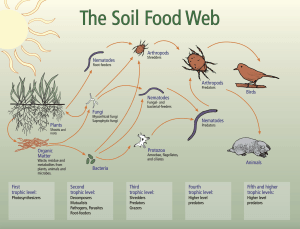An organic fertilization program focuses on your soil’s quality. The aim is to nurture the soil and the soil food web in addition to feeding the plant. The soil food web to the multitude of life forms in the soil. These forms range from microscopic one-celled bacteria, algae, fungi, and protozoa, to larger nematodes, arthropods, earthworms, insects, plant roots, and small animals. These life forms help break down organic matter, aerate the soil, prey on unwanted pests, and make nutrients available to the grass. In order for your lawn to thrive it needs healthy soil to grow in.

A healthy soil environment must provide microorganisms with food, water, and oxygen. Without a balanced soil environment, beneficial microbes go dormant. Microorganisms prosper on carbon-based food sources that also provide other nutrients. Therefore, organic fertilizers add organic matter and carbon to the soil. Carbon, a moist environment, and adequate pore space to hold oxygen, all allow for beneficial microorganisms to be active in the soil. These beneficial microorganisms will then regulate the bad microorganisms in the soil.
Chemical fertilizers and pesticides act as irritants to many of these beneficial life forms, killing them or causing them to flee or go dormant. This has an adverse effect on the health of the soil, as your grass becomes dependent on the chemicals to grow rather than getting its nutrients from the soil. Properties routinely treated with chemicals will likely have compacted soil and thatch buildup.
Organic Fertilizers & Soil Health
Organic fertilizers feed the soil biology and the biology feeds the plant. Nutrients are released at a rate which the grass plant can absorb. This promotes healthy, steady growth that results in more uniform shoot and root growth than in a chemically treated lawn. Organic fertilizers also add organic matter and encourage beneficial microorganisms to live in the soil. These beneficial microorganisms will seek out and attack the bad microorganisms and help keep them in check.
Beneficial organisms can transform compacted soil into a soft porous medium. This soft porous soil is beneficial to the grass because it will have improved water retention characteristics, oxygen holding capacity, and nutrient holding capability. It will also be permeable so that the grass roots can more easily penetrate it; encouraging deeper, stronger roots. Roots don’t simply grow in dirt, roots grow in the pore space in the soil.
Achieving healthy soil may require extra patience while beneficial life forms return. It is critical that the soil food web is taken into account when trying to grow grass. A combination of all-natural products and cultural practices can be started immediately to create a healthy, sustainable lawn.








